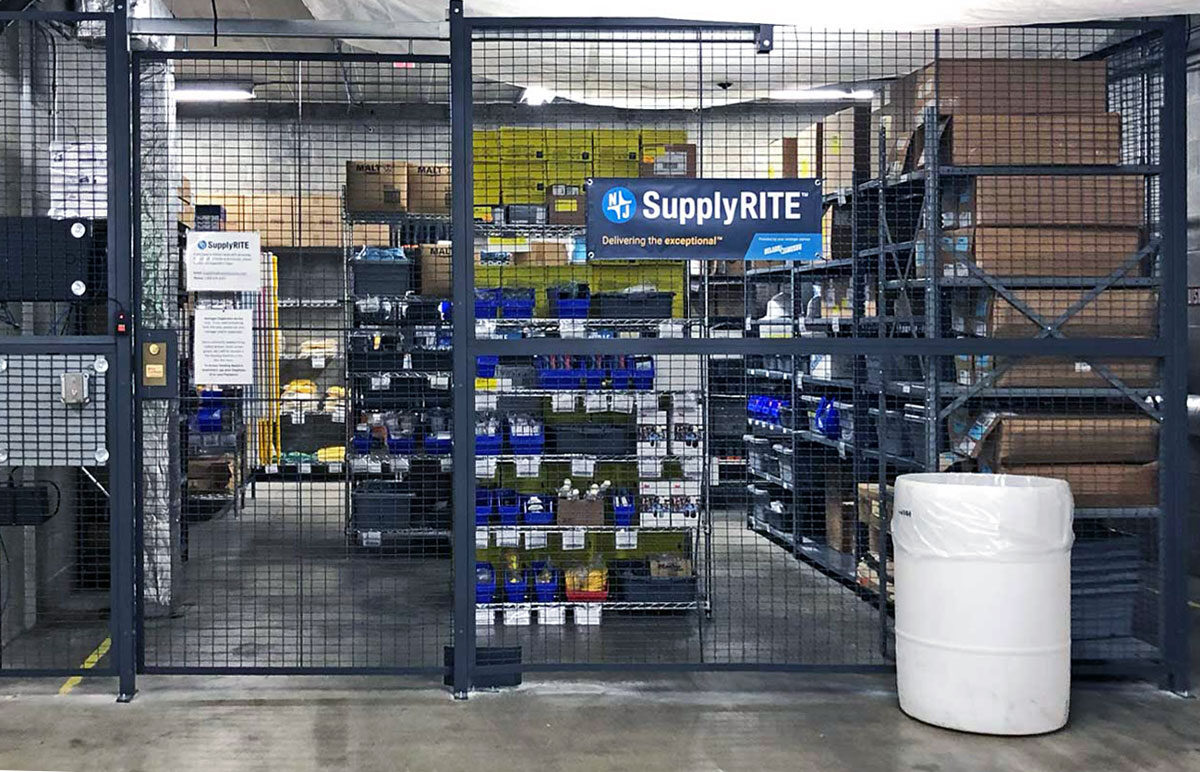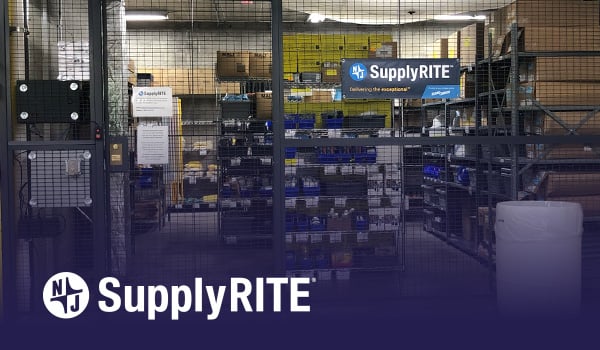Considering Vendor Managed Inventory (VMI) for your food processing plant? Before implementation, defining specific and measurable goals is necessary for success. Getting clarity in your objectives, whether it's reducing stockouts or enhancing supplier relationships, will provide a roadmap for effective VMI.
Ready to set the stage for a successful VMI implementation? Below, Nelson-Jameson shares five ways to first identify your inventory solutions needs.
1. Review your current inventory process with industry experts to uncover opportunities to combat facility challenges and create savings.
Why is an expert review so important?
- Uncover hidden challenges: Experts bring an objective viewpoint, identifying inefficiencies or bottlenecks that may be difficult to see from within your daily operations.
- Address facility-specific issues: Every food processing plant has unique challenges related to its products, equipment, and layout. Experts can tailor their advice to your specific circumstances.
- Create savings: By streamlining processes and reducing waste, an expert review can lead to significant cost savings in the long run.
- Customized Solutions: Expert advice is tailored to your specific needs from an objective viewpoint.
What does an expert review involve?
- Analysis of purchase history: Understanding what you buy, how often, and in what quantities is crucial for identifying trends and potential overstocking.
- Assessment of current inventory practices: Experts will examine your existing methods for inventory management and re-ordering processes to find areas for improvement.
- Definition of facility needs and challenges: It is essential to clearly understand your plant's unique requirements, such as managing perishable goods or complying with strict regulations.
- Establish specific, measurable, achievable, relevant, and time-bound (SMART) goals for your inventory management program. This ensures that any proposed solutions align with your overall business objectives.
An expert review is more than just a consultation; it's the first step toward transforming your inventory management from a cost center into a strategic advantage. By partnering with experienced professionals, you can unlock the full potential of your inventory and drive sustainable success for your food manufacturing operation.
"Experts bring an objective viewpoint, identifying inefficiencies or bottlenecks that may be difficult to see from within your daily operations."
2. Analyze your purchase history to define usage and assist in creating ordering parameters.
Effective inventory management is crucial for the success of any food processing operation. Analyzing your purchase history can reveal patterns, inefficiencies, and opportunities for significant improvements.
Why is Purchase History Analysis Important?
- Benchmark Usage: Understanding what products your facility uses most and how frequently they're consumed helps to predict future needs and avoid stockouts.
- Optimize Ordering Parameters: Analyzing purchase data allows you to establish efficient ordering methods, such as setting appropriate reorder points and quantities. This ensures enough stock without accumulating excess inventory.
- Reduce Dead Stock: By identifying slow-moving or obsolete items, you can prevent "dead stock" from tying up valuable resources and negatively impacting your bottom line.
- Streamline Processes: Use software to gain insights into usage information, reporting, and tracking.
How to Analyze Your Purchase History Effectively:
- Categorize Purchases: Group your purchases by product type (e.g., ingredients, packaging, MRO supplies) to identify spending patterns.
- Track Usage Over Time: Monitor how consumption varies over different periods (daily, weekly, monthly, seasonally) to anticipate demand fluctuations.
- Identify Key Suppliers: Determine which suppliers you rely on most and evaluate their performance in terms of lead times, product quality, and service.
- Assess Costs: Calculate the total cost of ownership for each item, including purchase price, shipping, handling, and storage.
By meticulously analyzing your purchase history, you can gain valuable insights into your facility's unique inventory needs.
3. Evaluate your current inventory management processes, systems, and capabilities to identify areas where VMI can add value.
Vendor Managed Inventory (VMI) can be a game-changer. Evaluating your current processes, systems, and capabilities will help determine if VMI is the right solution for your facility.
What is Vendor Managed Inventory (VMI)?
VMI is a supply chain strategy where the supplier takes responsibility for managing inventory levels at your location. The supplier monitors your stock, forecasts demand, and ensures you have the right stock at the right time.
Why Evaluate for VMI?
- Improved Inventory Management: VMI can lead to more accurate inventory levels, reducing stockouts and overstocking.
- Reduced Costs: Optimize stock levels to meet demand, minimizing storage costs and freeing up cash flow.
- Enhanced Supplier Collaboration: VMI fosters stronger, more trusting partnerships between you and your suppliers.
- Focus on Core Competencies: By outsourcing inventory management, your company can concentrate on core business activities, such as production and product development.
Key Evaluation Steps for VMI:
- Assess Your Current Inventory Management: Examine your existing inventory management methods and re-order processes to find areas for improvement.
- Analyze Inventory Turnover: VMI is most beneficial for businesses with high inventory turnover.
Review Your Current Systems: VMI implementation may require inventory management software and systems.
- Evaluate Demand Predictability: VMI works best when demand patterns are relatively stable and predictable.
- Consider Your Supplier Relationships: Strong, reliable relationships with your suppliers are essential for VMI success.
4. Define specific goals for implementing VMI, such as reducing stockouts, improving inventory turnover, or enhancing supplier relationships.
Successful inventory management is about more than just keeping shelves stocked. It's about achieving specific, measurable goals that align with your overall business strategy. If you're considering Vendor Managed Inventory (VMI), it's crucial to define exactly what you want to achieve.
Why Define Specific Goals for VMI?
- Focus and Direction: Clearly defined goals provide a roadmap for your VMI implementation, ensuring everyone is working towards the same objectives.
- Measurable Success: Specific goals allow you to track progress and measure the effectiveness of your VMI program.
- Improved Decision-Making: Knowing what you want to achieve helps you make informed decisions about which products to include in VMI, which suppliers to partner with, and how to optimize your processes.
- Better Communication: Clearly defined goals ensure effective communication and collaboration with your VMI partner.
Examples of VMI Goals:
- Reduce Stockouts: Minimize the risk of running out of critical items, ensuring uninterrupted production.
Improve Inventory Turnover: Optimize inventory levels to reduce holding costs and free up working capital.
- Enhance Supplier Relationships: Foster stronger collaboration and trust with key suppliers.
- Reduce Inventory Costs: Lower carrying costs, storage expenses, and the risk of obsolescence.
- Boost Productivity: Streamline inventory processes to free up your team to focus on other priorities.
- Reduce Lead Times: Decrease the amount of time between ordering and receiving goods.
- Increase Fulfillment Accuracy: Improve accuracy in meeting customer demand.
Defining Your VMI Goals:
- Evaluate Current Challenges: Identify pain points such as stockouts, overstocking, or inefficient processes
- Set SMART Objectives: Ensure your goals are Specific, Measurable, Achievable, Relevant, and Time-bound.
- Align with Business Strategy: Make sure your VMI goals support your company's overall strategic objectives.
- Consider Key Performance Indicators (KPIs): Decide which metrics you will track to measure progress, such as inventory turnover rate, stock levels, and service levels.
What To Do After Defining Goals:
- Communicate Goals: Share your VMI goals with your team and your supplier to ensure everyone is aligned.
- Develop a Plan: Create a detailed plan outlining the steps required to achieve your goals.
- Implement Technology Solutions: Invest in vendor-managed inventory software that integrates with your existing systems.
- Monitor and Evaluate: Track your progress regularly and make adjustments as needed.
Continuously Improve: Solicit feedback and refine your processes to optimize results.
5. Assess whether your business experiences consistent demand for its products or services
Predictable demand is a cornerstone of efficient inventory management. Before implementing solutions like Vendor Managed Inventory (VMI), it’s crucial to determine if your food manufacturing plant experiences consistent demand for its products or services. This assessment helps you choose the right strategies and optimize your supply chain.
Three Strategies to Assess Demand:
1. Analyze Historical Sales Data:
- Track year-over-year orders to identify customer buying patterns and prepare for seasonal rushes and slow-downs.
- Evaluate SKU intensity by tracking sales data to see which product variations sell as a ratio of how much each is produced.
- Use historical data to anticipate food demand accurately and avoid over-buying ingredients.
2. Monitor Real-Time Sales and Consumption:
- Implement real-time reporting systems to monitor production and performance metrics.
- Analyze data from sales, customer behavior, and market trends to make data-driven decisions regarding production volumes, inventory levels, and product assortment.
- Track rate of sale/consumption at the customer’s location to determine the appropriate replenishment frequency and avoid stockouts.
3. Consider External Factors and Market Trends:
- Anticipate demand fluctuations by staying informed about market dynamics and consumer preferences.
- Look at market trend analysis and anticipate market trends.
Your VMI partner
Have questions about inventory solutions? We have answers. Reach out to Nelson-Jameson to partner with us and begin your VMI journey today!




.jpg)
